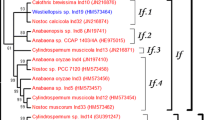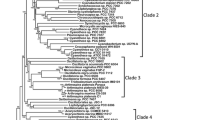Abstract
Taxonomic affiliations and molecular diversity of 41 heterocystous cyanobacteria representing 12 genera have been assessed on an evolutionary landscape using rbcl gene sequence data-based phylogenomics and evogenomics approaches. Phylogenetic affiliations have clearly demonstrated the polyphyly of the true branching cyanobacteria, along with a frequent intermixing amongst the heterocystous cyanobacteria. The monophyletic origin of the heterocystous cyanobacteria was also quite evident from maximum parsimony and neighbor joining analyses. Incongruency with the traditional scheme of cyanobacterial taxonomy was frequently observed, thus advocating towards some re-amendments in the cyanobacterial classificatory schemes. Evogenomics analyses of gene sequence data gave a clear indication about the greater evolutionary pace of the unbranched cyanobacteria as compared to the branched forms. It was evident that the order Nostocales would be controlling the future pace of evolution of heterocystous cyanobacteria. The cyanobacteria Nostoc was found to have the greatest genetic heterogeneity amongst the studied genera, along with some evidence towards events of lateral gene transfer amongst the heterocystous cyanobacteria in case of the rbcl gene. Thus, heterocystous cyanobacteria were found to be a fast evolving group, with estimates of gene conversion tracts pointing towards the unbranched heterocystous cyanobacteria being at the base of evolutionary diversifications of the complete heterocystous lineage.


Similar content being viewed by others
References
Berrendero E, Perona E, Mateo P (2008) Genetic and morphological characterization of Rivularia and Calothrix (Nostocales, Cyanobacteria) from running water. Int J Syst Evol Microbiol 58:447–460
Desikachary TV (1959) Cyanophyta, part I and II. Indian Council of Agricultural Research, New Delhi
Felsenstein J (1985) Confidence limits on phylogenies: an approach using the bootstrap. Evolution 39:783–791
Gascuel O, Steel M (2006) Neighbor-joining revealed. Mol Biol Evol 23:1997–2000
Giovannoni SJ, Turner S, Olsen GJ, Barns S, Lane DJ, Pace NR (1988) Evolutionary relationships among cyanobacteria and green chloroplasts. J Bacteriol 170:3584–3592
Gugger M, Hoffmann L (2004) Polyphyly of the true branching cyanobacteria (Stigonematales). Int J Syst Evol Microbiol 54:349–357
Gugger M, Lyra C, Henrikson P, Coute A, Humbert JF, Sivonen K (2002) Phylogenetic comparison of the cyanobacterial genera Anabaena and Aphanizomenon. Int J Syst Evol Microbiol 52:1867–1880
Halinen K, Jokela J, Fewer DP, Wahlsten M, Sivonen K (2007) Direct evidence for production of microcystins by Anabaena strains from the Baltic Sea. Appl Environ Microbiol 73:6543–6550
Hartmann LS, Barnum SR (2010) Inferring the evolutionary history of mo-dependent nitrogen fixation from phylogenetic studies of nifK and nifDK. J Mol Evol 71:70–85
Henson BJ, Hesselbrock SM, Watson LE, Barnum SR (2004) Molecular phylogeny of the heterocystous cyanobacteria (subsections IV and V) based on nifD. Int J Syst Evol Microbiol 54:493–497
Honda D, Yokota A, Sugiyama J (1999) Detection of seven major evolutionary lineages in cyanobacteria based on the 16S rRNA gene sequence analysis with new sequences of five marine Synechococcus strains. J Mol Evol 48:723–739
Iteman I, Rippka R, Tandeau de Marsac N, Herdman M (2002) rdna analyses of planktonic heterocystous cyanobacteria, including members of the genera Anabaenopsis and Cyanospira. Microbiology 148:481–496
Komárek J, Anagnostidis K (1989) Modern approach to the classification system of cyanophytes 4 Nostocales. Arch Hydrobiol Suppl 82:247–345
Lammers P, Haselkorn R (1984) Sequence of the nifD gene coding for the α subunit from the cyanobacterium Anabaena. Cell 44:905–911
Lee DH, Zo YG, Kim SJ (1996) Non-radioactive method to study genetic profiles of bacterial communities by PCR-single strand conformation polymorphism. Appl Environ Microbiol 62:3112–3120
Librado P, Rozas J (2009) DnaSP v5: a software for comprehensive analysis of DNA Polymorphism data. Bioinformatics 25:1451–1452
Ludwig W, Schleifer KH (1994) Bacterial phylogeny based on 16S and 23S rRNA sequence analysis. FEMS Microbiol Rev 15:155–173
Meeks JC, Elhai J (2002) Regulation of cellular differentiation in filamentous cyanobacteria in free-living and plant-associated symbiotic growth states. Microbiol Mol Biol Rev 66:94–121
Mishra AK, Shukla E, Singh SS (2013) Phylogenetic comparison among the heterocystous cyanobacteria based on a polyphasic approach. Protoplasma 250:77–94
Mollenhauer D (1988) Nostoc species in the field. Arch Hydrobiol Suppl 80:315–326
Morden CW, Golden SS (1991) Sequence analysis and phylogenetic reconstruction of the genes encoding the large and small subunits of ribulose-1,5-bisphosphate carboxylase/oxygenase from the chlorophyll b-containing prokaryote Prochlorothrix hollandica. J Mol Evol 32:379–395
Nei M, Kumar S (2000) Molecular evolution and phylogenetics. Oxford University Press, New York
Neilan BA, Burns BP, Relman DA, Lowe DR (2002) Molecular identification of cyanobacteria associated with stromatolites from distinct geographical locations. Astrobiology 2:271–280
Nelissen B, De Baere R, Wilmotte A, De Wachter R (1996) Phylogenetic relationships of nonaxenic filamentous cyanobacterial strains based on 16S rRNA sequence analysis. J Mol Evol 42:194–200
Rajaniemi P, Hrouzek P, Kastovska K, Willame R, Rantala A, Hoffmann L, Komárek J, Sivonen K (2005) Phylogenetic and morphological evaluation of the genera Anabaena, Aphanizomenon, Trichormus and Nostoc (Nostocales, Cyanobacteria). Int J Syst Evol Microbiol 55:11–26
Rippka R, Deruelles J, Waterbury JB, Herdman M, Stanier RY (1979) Generic assignments, strain histories and properties of pure cultures of cyanobacteria. J Gen Microbiol 111:1–61
Saitou N, Nei M (1987) The neighbour joining method—a new method for reconstructing phylogenetic tree. Mol Biol Evol 4:406–425
Sihvonen LM, Lyra C, Fewer DP, Rajaniemi-Wacklin P, Lehtimáki JM, Wahlsten M, Sivonen K (2007) Strains of the cyanobacterial genera Calothrix and Rivularia isolated from the Baltic Sea display cryptic diversity and are distantly related to Gloeotrichia and Tolypothrix. FEMS Microbiol Ecol 61:74–84
Singh P, Singh SS, Mishra AK, Elster J (2013) Molecular phylogeny, population genetics and evolution of heterocystous cyanobacteria using nifH gene sequences. Protoplasma 250:751–764
Tamura K, Peterson D, Peterson N, Stecher G, Nei M, Kumar S (2011) MEGA5: molecular evolutionary genetics analysis using maximum likelihood, evolutionary distance and maximum parsimony methods. Mol Biol Evol 28:2731–2739
Yoon HS, Hackett JD, Ciniglia C, Pinto G, Bhattacharya D (2004) A molecular timeline for the origin of photosynthetic eukaryotes. Mol Biol Evol 21:809–818
Zehr JP, Mellon MT, Hiorns WD (1997) Phylogeny of cyanobacterial nifH genes: evolutionary implications and potential applications to natural assemblages. Microbiology 143:1443–1450
Acknowledgments
We are thankful to the Council of Scientific and Industrial Research, New Delhi for providing financial support. The Head of the Department of Botany, Banaras Hindu University, Varanasi, India is gratefully acknowledged for providing laboratory facilities.
Author information
Authors and Affiliations
Corresponding author
Rights and permissions
About this article
Cite this article
Singh, P., Fatma, A. & Mishra, A.K. Molecular phylogeny and evogenomics of heterocystous cyanobacteria using rbcl gene sequence data. Ann Microbiol 65, 799–807 (2015). https://doi.org/10.1007/s13213-014-0920-1
Received:
Accepted:
Published:
Issue Date:
DOI: https://doi.org/10.1007/s13213-014-0920-1




